Extraction and Visualization of Swirl and Tumble Motion from Engine Simulation Data |

|
The simulation data associated with in-cylinder tumble motion within a gas engine, given on an unstructured, time-varying and adaptive resolution CFD grid, demands robust visualization methods that apply to unsteady flow. We make effective use of animation to visualize the time-dependent simulation data. We also describe the challenges and implementation measures necessary in order to apply the presented methods to time-varying, volumetric grids.
- saddles are red
- sinks are blue
- sources are green
- cyan seperatrices depict separation line behavior (cyan seperatrices depict separation line behavior)
- dark blue seperatrices indicate non-separation line behavior
- singular edges are yellow (singular edges are yellow)
The AVI videos are viewable with MPlayer on Linux.

Extraction and visualization of time-dependent tumble motion: (left) Boundary flow topology and lambda-2 vortex extraction and volume rendering. (right) Image Space Advection (ISA) applied highlighting recirculation zones at the boundary surface.
[MPEG animation, 900 frames, 5122 resolution]
(~6 MB)
[AVI animation, 900 frames, 5122 resolution]
(~5 MB)

Extraction and visualization of swirl motion. Boundary topology is extracted and visualized at the same time vortices are extracted and volume rendered using the lamda-2 criterion.
[MPEG animation,800 frame, 512x512 resolution] (~6 MB)
[AVI animation,800 frame, 512x512 resolution] (~6 MB)
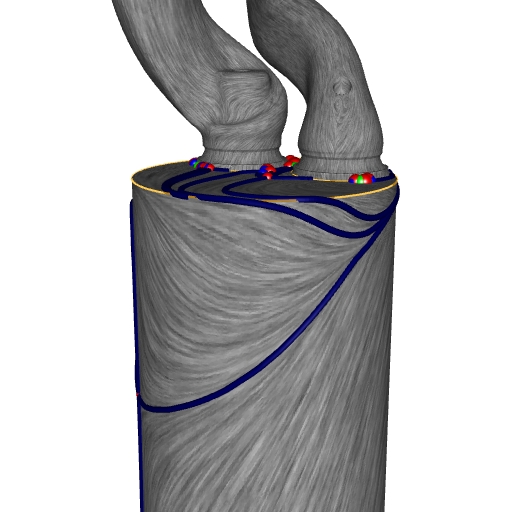
Visualization of swirl characteristics at the boundary surface using a hybrid of LIC and topology.
[MPEG animation, 800 frames, 512x512 resolution] (~5 MB)
[AVI animation, 800 frames, 512x512 resolution] (~6 MB)

Visualization of swirl characteristics at the boundary surface and within the volume with vortex core extraction and visualization.
[MPEG animation, 800 frames, 512x512 resolution] (~6 MB)
[AVI animation, 800 frames, 512x512 resolution] (~6 MB)

Visualization of tumble motion characteristics at the boundary surface using boundary topology extraction.
[MPEG animation, 800 frames, 512x512 resolution] (~6 MB)
[AVI animation, 800 frames, 512x512 resolution] (~6 MB)
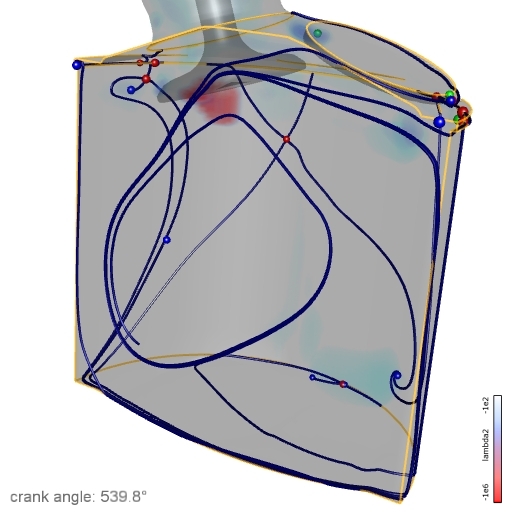
Visualization of tumble motion characteristics at the boundary surface using boundary topology extraction and lambda-2 vortex extraction with volume rendering.
[MPEG animation, 800 frames, 512x512 resolution] (~6 MB) [AVI animation, 800 frames, 512x512 resolution] (~6 MB)

Visualization of tumble motion characteristics at the boundary surface using boundary topology extraction and vortex extraction in conjunction with moving cutting planes.
[MPEG animation, 900 frames, 512x512 resolution] (~6 MB)
[AVI animation, 900 frames, 512x512 resolution] (~6 MB)

Visualization of tumble motion characteristics at the boundary surface using boundary topology extraction and vortex extraction in conjunction with moving cutting planes. This time the separatrices at the top and the bottom of the combustion chamber are removed for hightened visual clarity.
[MPEG animation, 900 frames, 512x512 resolution] (~7 MB)
[AVI animation, 800 frames, 512x512 resolution] (~7 MB)
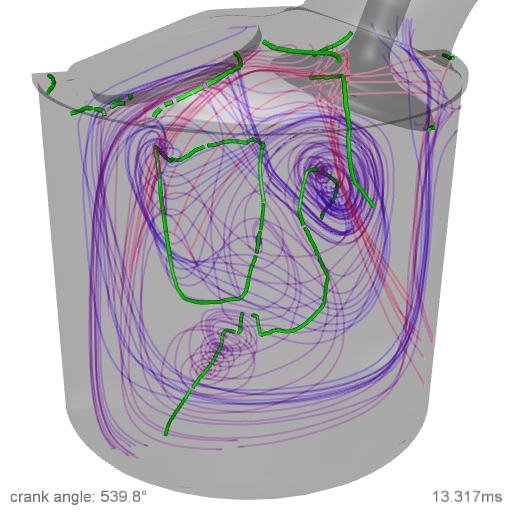
Visualization of tumble motion within the volume using a combination of vortex extraction and visualization with separatrices to highlight recirculation.
[MPEG animation, 800 frames, 512x512 resolution] (~6 MB)
[AVI animation, 800 frames, 512x512 resolution] (~6 MB)
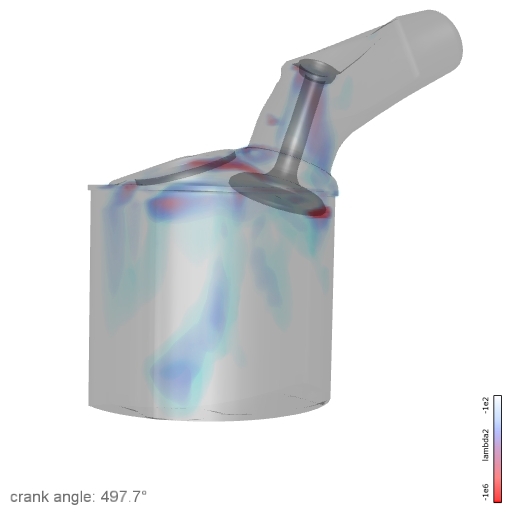
Volume rendering of the lambda-2 criterion. lamda-2 < 0 identifies a vortex. For better visualization, we omit small/weak vortices and actually show lambda-2 in the range from -1e2 (weak, transparent blue) to -1e6 (strong, red). The visualization result is the main diagonal hybrid swirl/tumble vortex at the end of the movie as well as the strong turbulence showing up near the valve through the charge cycle.
[MPEG animation, 800 frames, 512x512 resolution] (~5 MB)
[AVI animation, 800 frames, 512x512 resolution] (~1 MB)
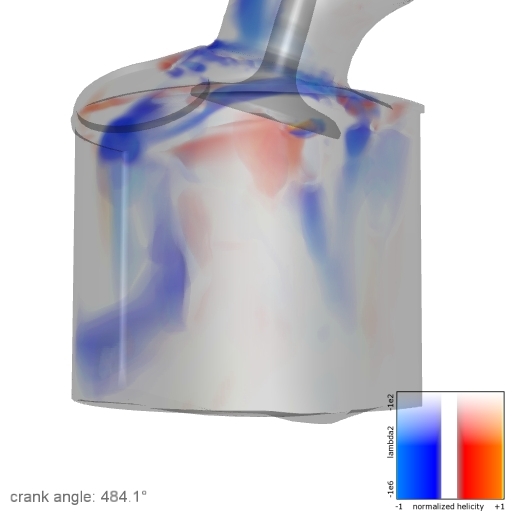
Volume rendering using a two-dimensional transfer function of lambda-2 and normalized helicity: This permits coloring of vortices according to rotation direction (transfer function shown in legend). Helicity is roughly the cosine of the angle between the velocity and vorticity vector. If they are parallel, the vortex rotates counter-clockwise in the direction of the flow, or clockwise if they are anti-parallel. Thus, normalized helicity occupies a range: [-1, 1]. The region where helicity is zero is omitted (transparent in the transfer function) and should therefore guarantee a better visual separation of neighboring vortices.
[MPEG animation, 800 frames, 512x512 resolution] (5 MB)
[AVI animation, 800 frames, 512x512 resolution] (~1.5 MB)
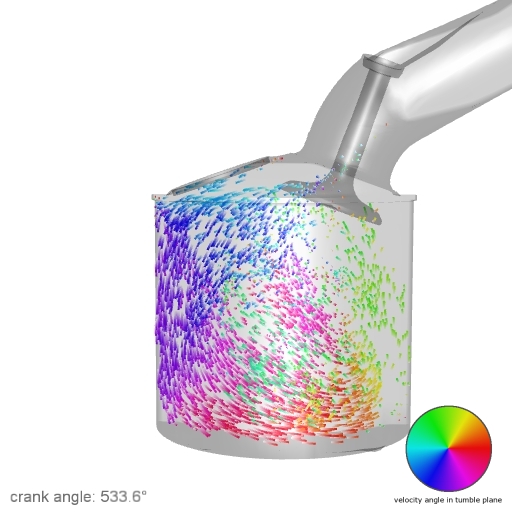
Pathlets visualizing tumble motion: the color coding indicates the angle in the tumble plane (see legend in the video). The observer can compare the actual flow pattern to the color wheel (ideal perfect tumble pattern).
[MPEG animation, 800 frames, 512x512 resolution] (~6 MB)
[AVI animation, 800 frames, 512x512 resolution] (~7 MB)

A hybrid visualization of particles and singularity paths. Particles swirling around vortex cores aid the visualization of vortex core strength.
[MPEG animation, 800 frames, 512x512 resolution] (~6 MB)
[AVI animation, 800 frames, 512x512 resolution] (~7 MB)
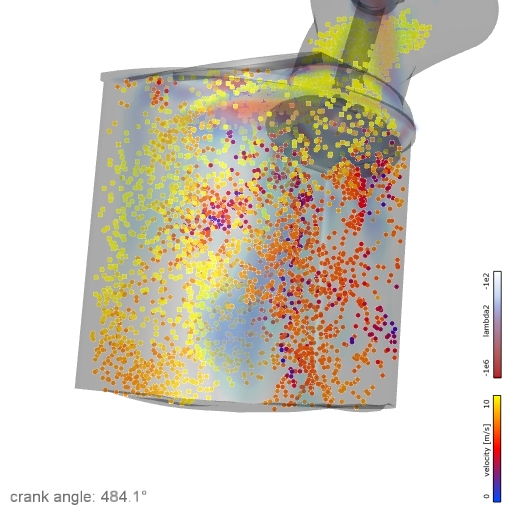
A hybrid visualization of particles and vortex core extraction using lambda-2. Particles swirling around vortex cores aid the visualization of vortex core strength as does the transfer function used in the volume rendering.
[MPEG animation, 800 frames, 512x512 resolution] (~6 MB)
[AVI animation, 800 frames, 512x512 resolution] (~7 MB)